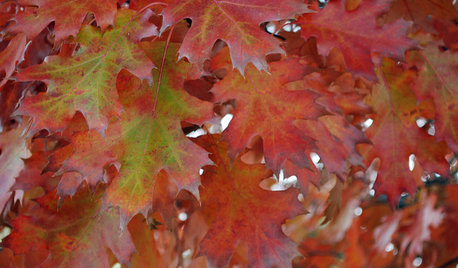Soil Depleted, Composting Oak Leaves
len1
15 years ago
Related Stories

GARDENING GUIDESGet on a Composting Kick (Hello, Free Fertilizer!)
Quit shelling out for pricey substitutes that aren’t even as good. Here’s how to give your soil the best while lightening your trash load
Full Story
GARDENING GUIDESGardening Solutions for Dry, Sandy Soils
Has your desert or beachy site withered your gardening creativity? Try these ideas for a beautiful, easy-care landscape
Full Story
FARM YOUR YARDHow to Get Good Soil for Your Edible Garden
The nutrients in your soil feed the plants that feed you. Here are tips on getting it right — just in time for planting season
Full Story
GARDENING GUIDESHow to Stop Worrying and Start Loving Clay Soil
Clay has many more benefits than you might imagine
Full Story
FALL GARDENING5 Ways to Put Fall Leaves to Work in Your Garden
Improve your soil and yard the organic way with a valuable garden booster that grows on trees
Full Story
GARDENING GUIDESHow to Pick a Mulch — and Why Your Soil Wants It
There's more to topdressing than shredded wood. Learn about mulch types, costs and design considerations here
Full Story
GARDENING GUIDES10 Solutions for Soggy Soil
If a too-wet garden is raining on your parade, try these water-loving plants and other ideas for handling all of that H2O
Full Story
GARDENING GUIDES6 Healthy Ways to Handle Fallen Leaves
Once nature's beautiful bounty is spent, these ecofriendly strategies for leaves will put your yard in the clear
Full Story
GARDENING GUIDESNew Ways to Think About All That Mulch in the Garden
Before you go making a mountain out of a mulch hill, learn the facts about what your plants and soil really want
Full Story
GARDENING GUIDESGarden Myths to Debunk as You Dig This Fall and Rest Over Winter
Termites hate wood mulch, don’t amend soil for trees, avoid gravel in planters — and more nuggets of garden wisdom
Full Story






west9491
soilguy
Related Professionals
Bellflower Landscape Architects & Landscape Designers · Kenmore Landscape Architects & Landscape Designers · Desert Hot Springs Landscape Contractors · Fort Wayne Landscape Contractors · Lorain Landscape Contractors · Lynwood Landscape Contractors · Secaucus Landscape Contractors · Boise Decks, Patios & Outdoor Enclosures · Fresno Decks, Patios & Outdoor Enclosures · Lockport Decks, Patios & Outdoor Enclosures · New Lenox Decks, Patios & Outdoor Enclosures · Philadelphia Decks, Patios & Outdoor Enclosures · Pueblo West Decks, Patios & Outdoor Enclosures · Rogers Decks, Patios & Outdoor Enclosures · San Diego Decks, Patios & Outdoor EnclosuresKimmsr
Lloyd
Kimmsr
Lloyd
sunnyside1
Lloyd
soilguy
dchall_san_antonio
jeannie7
dchall_san_antonio
Lloyd
toxcrusadr
soilguy
Kimmsr
val_s
Lloyd
len1Original Author
soilguy
cowgirl2
jeannie7
val_s
soilguy
Kimmsr
Lloyd
soilguy